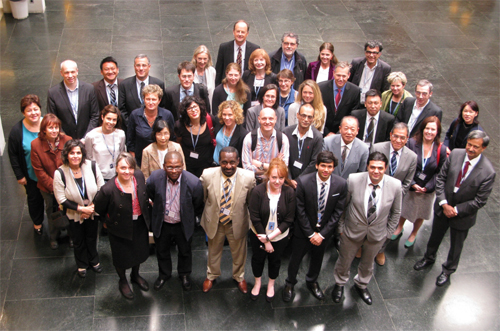In April, the World Health Organization (WHO) released the world’s first international treatment guidelines for hepatitis C virus infection. “There is increasing recognition that hepatitis C is a major global pandemic that has been very poorly addressed,” says TREAT Asia’s research director, Dr. Nicolas Durier, who was a member of the group that developed the new guidelines. “The previous lack of WHO guidelines implied that it was not an important topic.”

The hepatitis C treatment guideline development group, including TREAT Asia’s Dr. Nicolas Durier (second row, sixth from the left.) (PHOTO: WHO)
An estimated 150–180 million people are infected with hepatitis C globally, and about five million of them are co-infected with HIV. However, currently available hepatitis C treatments are complex and expensive, and most governments in resource-limited settings do not cover the costs of treatment. Due to low rates of treatment access, an estimated 350,000–500,000 people die as a result of hepatitis C each year.
The WHO’s new treatment guidelines provide a blueprint for change. They cover key aspects of hepatitis C care, including who should be tested, how to assess the extent of hepatitis C-related liver disease, which treatment regimens to use, and how to monitor patient progress. Individual governments remain responsible for implementing the recommendations. “Governments need to put in the resources, or secure outside support, so they can roll out testing and treatment for hepatitis C,” says Durier.
However, treatment cost is a barrier to putting the guidelines into practice. The most commonly used hepatitis C regimen, the injectable drug pegylated interferon combined with the oral drug ribavirin, has typically ranged between US$18,000 and US$33,000 for a single patient. Two newly approved oral hepatitis C medicines, sofosbuvir (SovaldiTM) and simeprevir (OlysioTM), offer shorter treatment courses, have fewer side effects, and provide higher cure rates. Although the guidelines strongly recommend the use of these new drugs when possible, with an initial price tag of US$66,000–$84,000 per patient per treatment, they remain inaccessible in most countries. “These drugs represent such dramatic progress in our ability to treat hepatitis C that they had to be included,” says Durier of the panel’s decision to recommend the drugs despite the high price. “Plus, we hope the recommendation will serve to push down the price of these medicines.”
Preliminary price negotiations are currently underway. Egypt, which has the world’s highest prevalence of hepatitis C, has negotiated a price of $900 for a course of SovaldiTM, and its maker Gilead Sciences is reportedly negotiating a $2,000 generic version that may be licensed to several Indian companies. However, advocates remain concerned that even with these cuts the drugs will remain inaccessible in most countries. “When you’re starting from such an exorbitant price in the U.S., the price Gilead will offer middle-income countries like Thailand and Indonesia may seem like a good discount, but it will still be too expensive for many of these countries to scale up treatment,” said Rohit Malpani, director of policy and advocacy for the Médecins Sans Frontières Access Campaign.